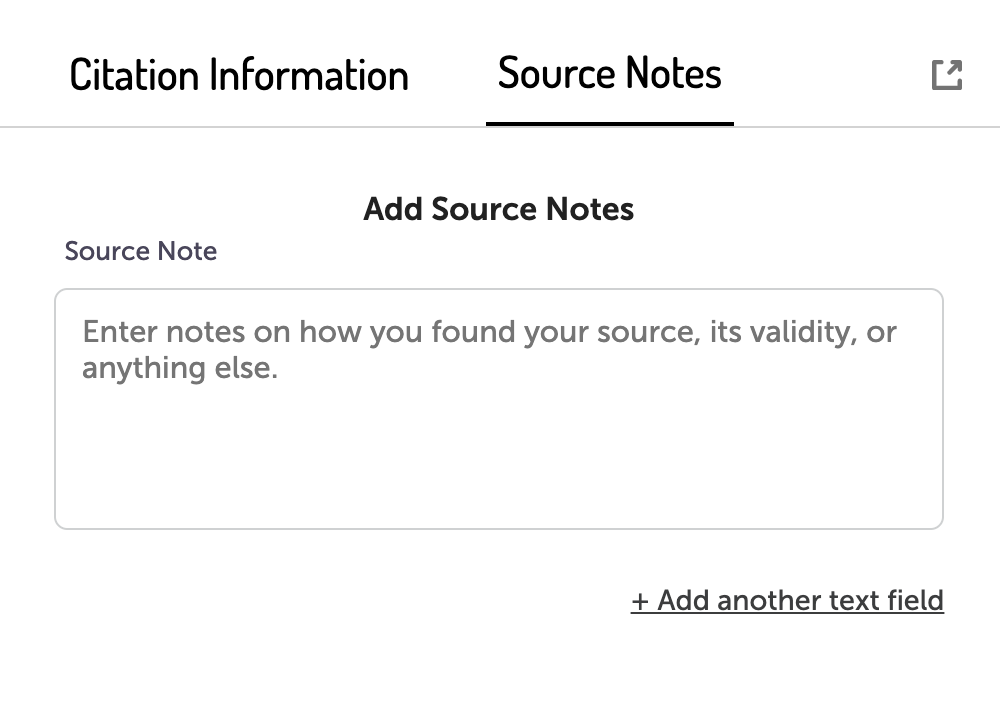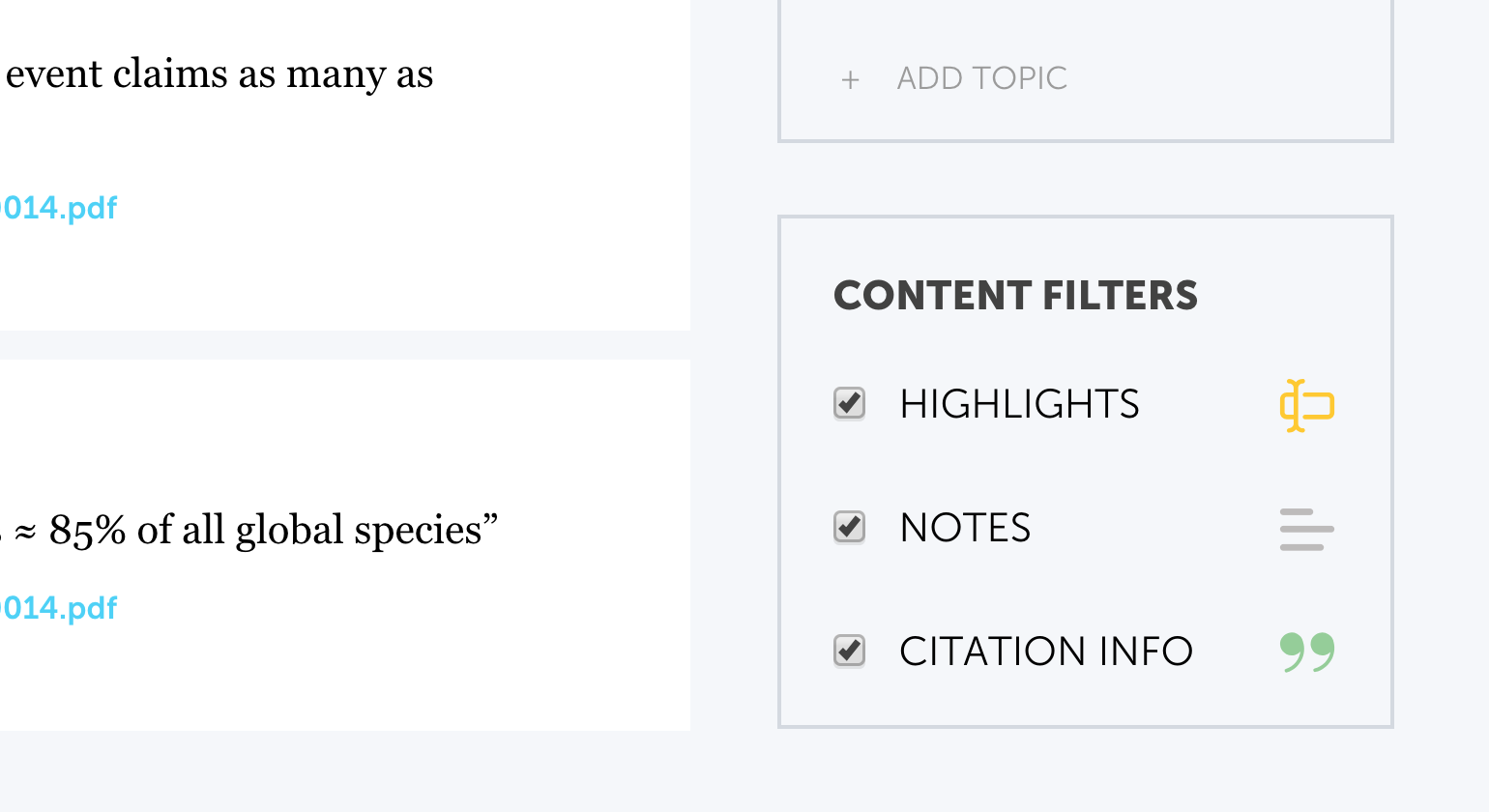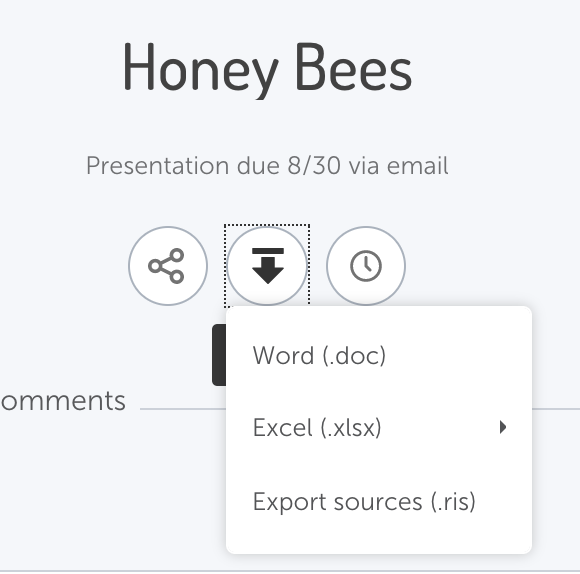Capturing Citations

Creating Citations with PowerNotes
In addition to gathering URLs and source links for all your sources, PowerNotes also captures citation information and generates formatted citations. Here’s how it works:
SAVING AND ACCESSING CITATION INFO IN THE EXTENSION
Once you’ve highlighted and saved a passage, PowerNotes will automatically capture the citation information provided by the source and provide you with a formatted citation.
To access and edit the citation, look for the Citation icon (large gray or green quotation mark) that can be found in two places:
- Note-taking Popup - the Citation icon is found at the bottom of the annotation popup that appears after you’ve highlighted and categorized something.
- Browser Sidebar - the Citation icon appears after each quoted highlight in the project sidebar.
Clicking on the Citation icon associated with a particular highlight will allow you to view and edit the associated citation information in the PowerNotes extension sidebar.

EDITING CITATIONS
PowerNotes will gather information on most websites to generate a citation. Every website, however, can provide different data pertaining to citations, so you might have to add or update some information if it’s insufficient or incorrect.
Here are a few things to know about how you can edit PowerNotes citations:
- Editing source metadata: source metadata is gathered and can be found in the “Detailed Citation Information” section. The metadata here can be changed by clicking into any of the text boxes and editing the information. Once you edit any metadata field(s), make sure you click the refresh icon (blue circle with white arrow) to update the citation.
- Manually add a DOI, ISBN, PMID, or arXiv: if for some reason the citation doesn’t populate in the Citation field, you can manually add a DOI, ISBN, PMID, or arXiv identifier by clicking on the link below the URL. You will then have a field to input one of those identifiers. After you put the identifier in, click the refresh icon to generate the citation.
- Manually add or edit a citation: at any time, you can edit the citation in the Citation field, or copy and paste one in, or manually type it into the field.
- Changing the citation format: to change the citation format, use the Format drop down menu to select the specific citation format (MLA, Chicago, AMA, APA, IEEE, Bluebook, etc.). If you don’t see the citation format you want, just ask us to add it.
- Check the citation and save your changes: automated citation generators are not always going to get it right, so check to make sure the citation is correct. Then click the Save button below the citation.
CITATION GENERATION FOR DIFFERENT TYPES OF SOURCES
PowerNotes gathers citation information a little differently depending on the type of source you’re using:
- General webpages and most academic databases: for sites like news sources, blogs, databases, etc., PowerNotes gathers the metadata necessary to put together a citation. Note that not all websites put all the info you need in their metadata, so you may need to add omitted information.
- PDFs from academic databases: for PDF documents, the database provider hosting the PDF usually provides the information we need to automatically generate the citation. So just highlight, and the citation should be there. If, for some reason, the citation field is blank, and you have a DOI, ISBN, PMID, or arXiv for the PDF, you can enter it manually by clicking on the link just below the URL in the citation pane. This will take you to a citation pane that will allow you to manually enter the DOI, ISBN, PMID, or arXiv. Once entered, just click the refresh icon above the right side of the citation field to generate the citation. If you don’t have any of those identifiers, you will need to enter the citation manually.
Legal research sites: for Westlaw, Lexis, Bloomberg Law, and HeinOnline, we automatically gather the citation provided by the site when available. You may edit the citation so that the format you want is correct.

Remember, you cannot always rely on the metadata provided websites or citations generated by machines. So check to make sure that the citations that you save are correct.
SOURCE NOTES
At the top of the citation pane, you’ll also see a Source Note tab. Source notes are a great place to add commentary, extra details, and analysis regarding a source (rather than the highlight). You can click the title text above the notes box to edit the title for each notes box. You can also add additional source note text boxes by clicking on the “+ Add another text field link” found below the last text box in the pane. For example, you may find it beneficial to add a field labeled “Search Results” and add a note about how you came across this particular source.

CITATIONS IN THE PROJECT OUTLINE
Any citation that you create and save will appear attached to your notes from that source in your Project Outline.

In your Project Outline, you can quickly view all of your citation info by showing citations using the filters on the right side of the project outline page.

Saved citation information can also be downloaded when you decide to export your work. Click on the download icon under the project outline title to export your work to a word processing file, spreadsheet, or .RIS file. Note that the download to a word processing or .RIS file (that can be opened in Google Docs or MS Word), will only export saved citations (meaning those citations where the Citation icon is filled in and green).What’s a .RIS file? An RIS file is a universal source metadata file that you can import into other citation management tools such as EasyBib, Zotero, EndNote, and Refworks to create a bibliography.

If you don't have the PowerNotes Chrome extension installed you can get it here. For more tips and information on how to use PowerNotes, see our help page.
If you have any issues using the citation feature, feel free to get in touch with us.
